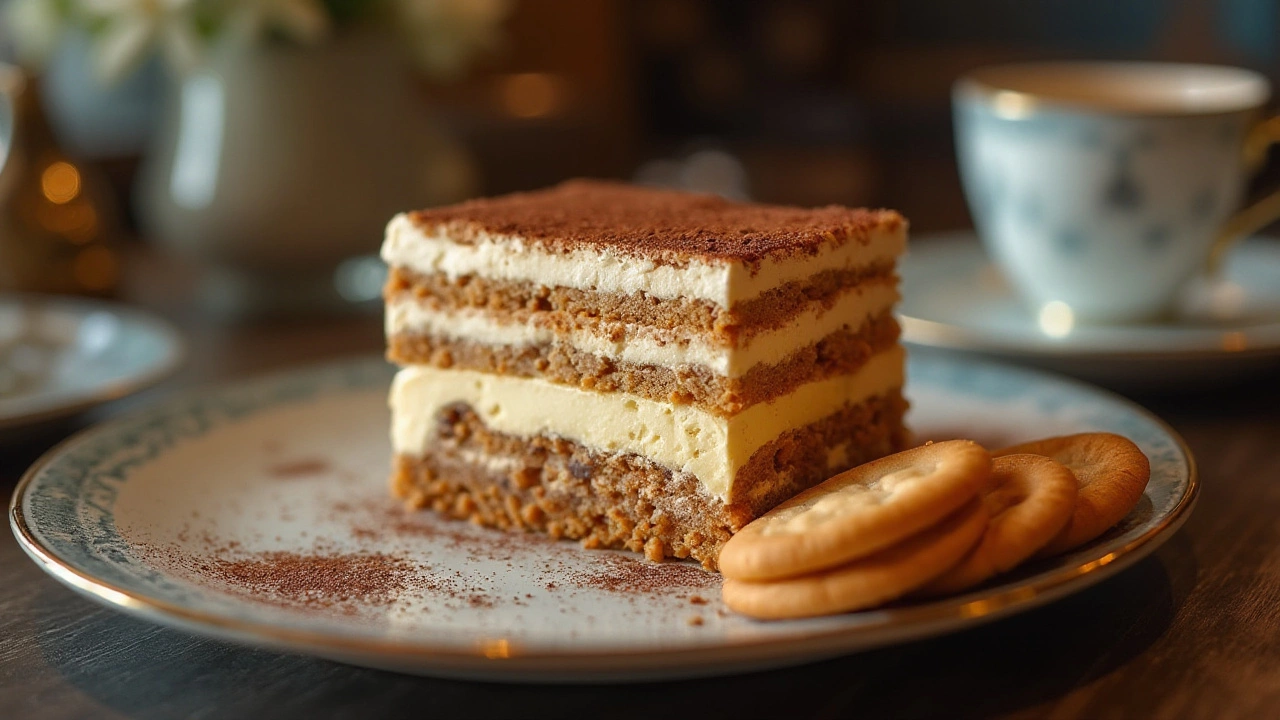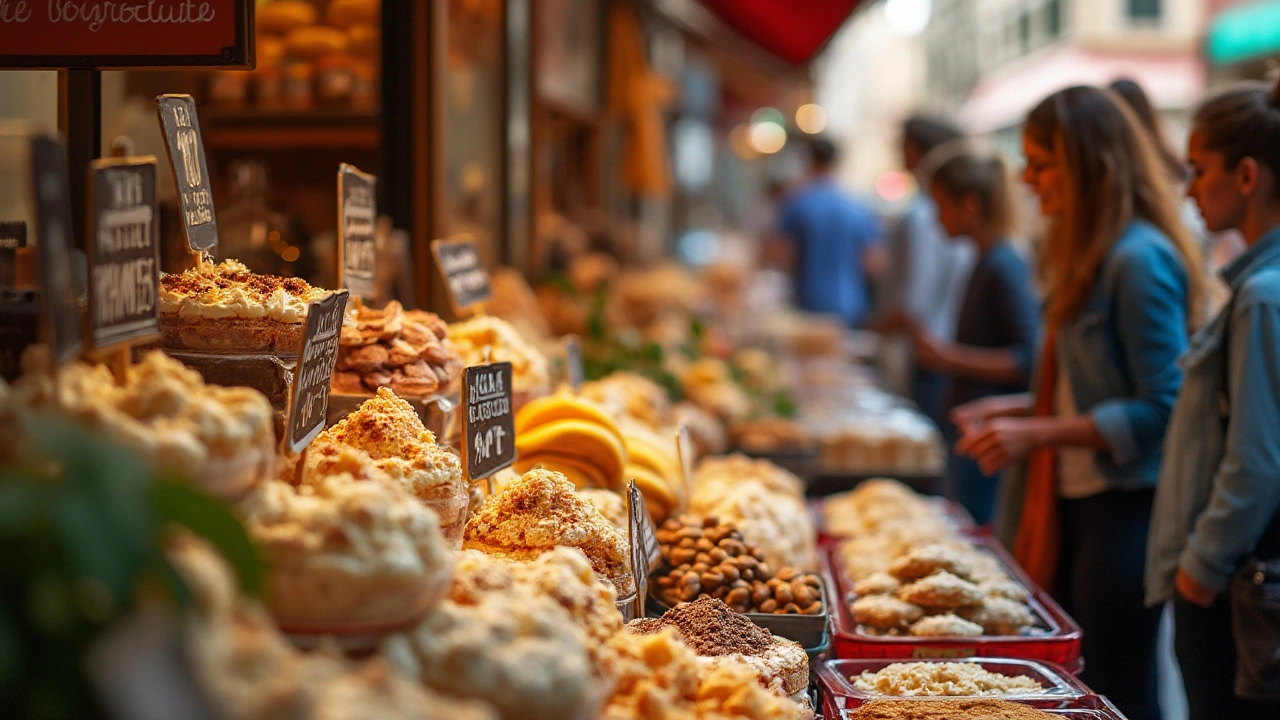
Tiramisu is not just a dessert; it's a journey through Italian culinary tradition. With its rich layers of coffee-soaked savoiardi and creamy mascarpone, it's no wonder this dessert is beloved around the world. But what truly makes a tiramisu the best? Is it the quality of the coffee or the texture of the mascarpone?
Join us as we sift through the ingredients that make the difference and explore the artistry behind each layer. Whether it's sticking to classic recipes or experimenting with modern twists, we aim to uncover the secrets to creating a tiramisu that leaves a lasting impression.
From its humble origins to its revered status in fine dining, we'll chart the course of tiramisu's rise and reveal where you can find the most exquisite versions today. Prepare to indulge your senses as we delve into the decadent world of tiramisu mastery.
- The Origins of Tiramisu
- Ingredients that Make a Difference
- Crafting the Perfect Layers
- Innovative Twists on a Classic
- Where to Taste the Best Tiramisu
The Origins of Tiramisu
The story of tiramisu, a dessert that has captured the hearts and palates of many, is as rich and layered as the dessert itself. While its roots are deeply embedded in Italian cuisine, its exact origins are shrouded in mystery and lore. What we do know is that tiramisu, literally translated to "pick me up," has become synonymous with a sweet, affectional conclusion to a meal, kindling smiles across the world from its piquant mix of coffee and creamy elements.
It is widely believed that tiramisu originated in the northeastern region of Italy, with claims from both Treviso in Veneto and Friuli Venezia Giulia. The name 'tiramisu' did not appear in cookbooks until the 1960s, lending to the theory that it was a relatively modern creation. Some historians even narrate anecdotal tales of its invention in the kitchen of Le Beccherie, a restaurant in Treviso. This locale has long laid claim to being the birthplace of the dessert, where it was allegedly first whipped up as a rejuvenating treat for patrons.
"Tiramisu holds the quiet strength of Italy's culinary prowess – a delicate dance of flavors that symbolically lifts spirits, much like its name," commented Felicity Cloake, a well-known food writer.
Aside from Italy, the evolution of tiramisu tells a fascinating tale of adaptation and adornment. The confection was said to provide a nourishing yet inexpensive dessert option during times of economic austerity. Step by step, ingredients were refined, with the once humble dessert evolving into the luxurious cake beloved today. This metamorphosis involves pivotal changes such as the incorporation of mascarpone cheese, replacing earlier renditions that merely used cream.
Historically significant, as tiramisu garners accolades globally, its growth mirrors the spread of Italian gastronomic philosophy. Embracing simplicity, yet celebrating intricate flavors, it reveals the tenets foundational to northern Italy's culinary ethos. Amid discussions, one can't help but appreciate how this dessert epitomizes not just taste, but culture, history, and creativity. Its global journey stands testament to the ways traditional recipes adapt to become shared treasures – true gems transcending geographical barriers. But, regardless of origin debates, its place as one of the world's best-loved Italian desserts remains undisputed and ever assured. The best dessert one could close a delightful meal with.
Ingredients that Make a Difference
The magic of a truly unforgettable tiramisu lies in the details, chiefly, its ingredients. One might think the typical components are set in stone - mascarpone, eggs, sugar, coffee, cocoa, and savoiardi biscuits. However, what's crucial is not just the presence of these ingredients, but their quality and freshness. The allure of a tiramisu rests on using fresh, silky mascarpone, whose creaminess is unmatched. This Italian cheese brings the dessert's signature smooth texture, and when paired with freshly brewed coffee, it creates a flavor symphony. It’s essential to choose a robust coffee variety, such as espresso, to penetrate the sweet layers of mascarpone and complement its richness.
Eggs must be at their freshest to achieve that light yet creamy custard. They should be pasteurized to ensure safety when consuming the uncooked dessert. Sugar is sometimes overlooked but plays a critical role in drawing out the deeper flavors in both coffee and cocoa without overwhelming the palate. As for the savoiardi, these delicate ladyfingers act as the foundation of the dessert. High-quality, Italian-made savoiardi will absorb the coffee without becoming soggy, striking the perfect balance between firmness and moistness.
The cocoa powder chosen for dusting should be rich and robust, not the sweetened kind often found in grocery stores. A full-bodied unsweetened cocoa enriches each bite, adding a slight bitterness to balance the sweetness. In some innovative kitchens, variations include adding a splash of Marsala wine, rum, or even amaretto to the coffee, which can lend a new depth of flavor. Such enhancements have evolved from pure tradition, showing the dessert's versatility while still honoring its roots.
"A well-prepared tiramisu is a delicate dance of flavors that can transport you straight to Italy," says renowned pastry chef Anna Campagnolo. She emphasizes choosing quality over convenience, a sentiment echoed by many culinary experts.
While purists may argue against such deviations, embracing the basic principles while adding personal touches gives each tiramisu its unique character. Whether you adhere to strict traditional methods or explore creative alternatives, remember that the soul of an exceptional tiramisu lies in the integrity of its ingredients. Here is a glimpse of some insights on variations:
| Ingredient Variation | Flavor Impact |
|---|---|
| Dark Rum | Adds warmth and enhances coffee flavors |
| Amaretto | Gives a nutty, sweet edge to complement the mascarpone |
| Marsala Wine | Imparts a sweet, fortified layer of flavor |
The artistry of making a successful tiramisu is in the details. From selecting the highest quality ingredients to understanding how they all work together, it's the small choices that create a dessert worthy of the name "world's best tiramisu." By focusing on these fundamentals, the resulting creation can transcend ordinary into something decidedly spectacular.

Crafting the Perfect Layers
The art of creating the perfect tiramisu lies in mastering its layers, each offering a distinct role, flavor, and texture that seamlessly blend to make this dessert truly delightful. At its heart, tiramisu layers must balance the rich creaminess of mascarpone with the bold aroma of coffee-infused savoiardi. To achieve this, one must pay close attention to the quality of each component, ensuring they all contribute to the dessert's enchanting harmony. It starts with choosing fresh mascarpone—its rich, buttery consistency is what gives tiramisu its luxurious mouthfeel. Mascarpone, slightly sweet and velvety, forms the backbone of the dessert's textural contrast.
The savoiardi or ladyfingers offer the necessary structure. These delicate sponge fingers should be soaked in a blend of espresso and a splash of coffee liqueur, but not to the point of saturation, since a soggy texture would ruin the overall balance. Instead, aim to achieve a state where the savoiardi absorb enough of the liquid to impart a deep coffee flavor, yet retain a touch of their inherent crispness to provide subtle resistance when bitten into. The coffee flavor is crucial, adding depth and cutting through the richness of the cream.
The dance of flavors is heightened with a layer of cocoa powder. This isn't simply a decorative dusting; it's an essential aspect of tiramisu. The cocoa should be unsweetened, providing a bitter counterpoint that elevates each spoonful, preventing the dessert from becoming overwhelmingly sweet. An optimal balance of sweetness not only makes each layer distinct but serves to enhance the unique experience of eating tiramisu. Indeed, as culinary legend Claudia Roden notes, "In baking, it's all about harmony—flavors must sing together yet stand alone."
The layering process is as pivotal as the ingredients. Each layer should be smooth and even, a careful choreography of spreading mascarpone cream over coffee-soaked savoiardi. It's not just about stacking; it's about creating a tiered symphony of flavors and textures. Ideally, a classic tiramisu consists of two rounds of layering, starting and ending with the mascarpone cream, then finished with a generous layer of cocoa. This sequence ensures every bite encapsulates the intended blend of flavors.
Once assembled, patience is key. Allowing the tiramisu to rest in the fridge for several hours, or even overnight, is crucial. This time allows the flavors to meld together, achieving the dessert's signature harmony. During this time, the savoiardi continue to soften slightly, and the mascarpone firms up, resulting in a slice that holds together beautifully while still melting in the mouth. This resting period truly enhances the dessert's creamy-to-cloudy consistency, fulfilling the promise of an indulgent experience that defines the world's best tiramisu.
Innovative Twists on a Classic
While the classic tiramisu recipe has stood the test of time, chefs around the world have embraced a spirit of innovation, transforming this traditional delight into a canvas for creativity. Imagine biting into a tiramisu that starts with a familiar taste only to surprise you with a new flavor or texture. That’s the magic of reinventing a classic dessert like tiramisu. These days, you might find green tea, passion fruit, or even matcha flavors infusing into the layers, bringing an unexpected yet delightful taste to the palate.
Chefs are utilizing regional ingredients to give their twists a distinct identity. In some cases, the coffee component is replaced with more exotic drinks such as chai tea or berry-flavored syrups, each adding a unique twist that tickles the taste buds. For those with a penchant for a boozy kick, local liqueurs, ranging from limoncello to rum, are often drizzled over ladyfingers, providing a flavorful punch that enhances the dessert’s allure. Each layer of mascarpone can also be enhanced with a variety of creams or custards, offering both depth and complexity.
One fascinating transformation of tiramisu has been the deconstructed version, where each component is arranged separately and presented in a modern, artful manner. This style not only showcases the individual ingredients but also allows diners to appreciate each flavor and texture distinctly. Additionally, culinary creativity has led to forming tiramisu in unique shapes and presentations, ranging from cups and jars to elaborate domes and towers, adding a visual appeal that complements its delicious taste.
According to renowned chef Massimo Bottura, "Innovation is about respecting tradition enough to reinvent it in a way that honors its origins but speaks to today." This philosophy is evident in how tiramisu is making waves with each reinvention, showcasing both creativity and respect for its Italian roots.
In this era of dietary mindfulness, it's exciting to see how new variants cater to different dietary needs, including gluten-free, vegan, and sugar-free iterations. Chefs have ingeniously substituted traditional ingredients like savoiardi with gluten-free options or have created mascarpone alternatives using coconut or cashew-based ingredients. Not only does this broaden the accessibility of tiramisu, but it also ensures everyone can enjoy a slice of this delectable team of layers.
As food trends continue to evolve, the future holds limitless possibilities for tiramisu. Whether you stick to the beloved classic or choose to explore one of its exciting renditions, this dessert exemplifies how innovation can breath new life into culinary traditions. Embrace these variations with an adventurous palate, and you may find yourself a new favorite in the delightful world of Italian desserts.

Where to Taste the Best Tiramisu
To discover the best tiramisu you've ever tasted, one must embark on a flavorful journey that spans charming Italian cafés to highly acclaimed restaurants around the globe. This classic dessert has not only conquered hearts in its native Italy but has also become a star on dessert menus worldwide. For the purists, a visit to the Veneto region, often heralded as the birthplace of tiramisu, is essential. In Treviso, you'll find countless eateries each claiming to have perfected the art of creating the most authentic, melt-in-your-mouth experience that will transport you back to the origins of this delightful creation.
The secret to tasting the finest tiramisu lies in paying close attention to the texture and balance of ingredients. Luxurious layers of creamy mascarpone should dance effortlessly with the robust flavors of espresso-soaked savoiardi, creating a harmonious blend that excites the palate. Some artisanal bakers have even introduced unexpected elements like fine liquors or unique cocoa powders that elevate traditional recipes. According to a renowned chef,
"The soul of a good tiramisu lies not just in its ingredients but in the care taken at every step of its preparation."This statement holds true as you explore various delicacies where this loving attention to detail transforms each bite into a memorable experience.
Remarkable twists on the classic tiramisu can also be found outside Italy, particularly in cities like New York or Paris. Here, chefs are constantly reinventing this beloved dessert, bringing new life into its cherished structure. Variants may include layers of flavored creams, such as a hint of pistachio or perhaps a fruity berry layer that adds a vibrant burst of color and freshness. These contemporary interpretations are well worth trying, as they offer both a nod to tradition and an invitation to explore beyond the familiar. To help you plan your culinary adventure, here's a suggestion: create a tiramisu tasting checklist, noting down recommended ones by locals or online food critics, which can guide you towards unforgettable experiences during your travels.